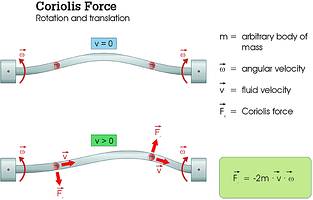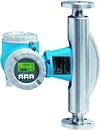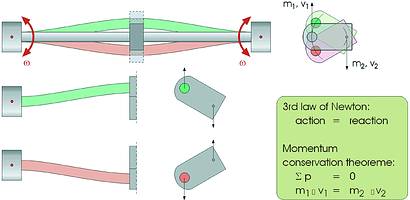
From its introduction decades ago, the Coriolis meter has progressed from infancy to being a well-accepted metering technique. This relatively quick success is very creditable in an industry that is known for its conservative outlook. Ultrasonic and Vortex shedding flowmeters for example, which have been available for over 30 years, often still struggle for recognition in certain areas.
There are many reasons for the Coriolis meter's success. Most importantly, the meter monitors the mass flowrate of gases and liquids directly in kilograms, tonnes, etc, without the need for any additional compensation, thereby offering many advantages in certain areas of process control. They generally require little space, are unaffected by flow profile, are simple to install, and cost-effective compared to an inferential system that will require a densitometer (or temperature and pressure probe), as well as an associated flow computer. Coriolis meters also have the ability to measure difficult media: slurries and high viscosity fluids such as chocolate, oil, tars, etc, with a relatively high accuracy.
Principle of operation
Whatever the tube geometry, all commercially available Coriolis meters operate on the same principle. The metering tube is excited at its natural frequency. Two sensors are located in the device, one on the inlet section of the metering tube and one on the outlet. Under no-flow conditions, the frequency signals monitored at the inlet and outlet sensors are in phase with each other. As product passes through the device a distortion of the measuring tubes occurs. This effective distortion is the Coriolis effect and occurs when a translational (or straight line) force acts on a rotational force. The rotational force is the oscillating tube and the translational force is the fluid moving in the tube (Figure 1). This Coriolis force or distortion results in a phase shift between inlet and outlet sensor signals that is proportional to the mass flowrate of the fluid flowing through the meter.

The frequency at which the tubes resonate is dependent upon the density of the fluid being metered; therefore the frequency signal picked up at the sensors can be used as the basis for density measurement. A temperature measurement is also made to compensate dynamic changes to the tubes due to expansion and contraction.
Single straight tube meters
Manufacturers have striven to make flowmeters as easy as possible to use and install. In the case of Coriolis mass flowmeters, the tube design is not of interest to the end user, but if as manufacturers we can supply a meter which is full bore and can be treated as a piece of pipe, this is something he can easily buy into. Minimal pressure loss and easy flow path on their own are obvious emotional advantages before considering any of the other benefits. A single straight tube meter is obviously the best solution for the end user, but also offers manufacturers the most challenging task in Coriolis mass flow.
Straight tube design was first introduced in 1985 with the Endress+Hauser m-Point, while this design had two straight tubes, it was a significant first step towards the single tube design and the materials required. Tube materials today are generally titanium or zirconium as in m-Point. The first commercially available single straight tube meters were introduced in 1988, but these were unbalanced meters, dogged by poor zero stability and impossible installation requirements.
The specific advantages for this design are obvious. For the food and beverage and pharmaceutical industries, single straight tube meters offer very high levels of hygiene, with surface roughness of the measuring tube as low < 0,4 (m (240 grit), virtually any process connection and many hygiene approvals including 3 A and EHEDG. Specific products such as yoghurt with fruit pieces, syrups, blood plasmas, cosmetics and all products that demand low shear stress, the single straight tube meter is a suitable solution. Other areas where this type of meter is a good choice are in products that may clog and where 'in place pigging' is a requirement.
The future of all Coriolis meter designs will obviously be a single straight tube. For now sizes are restricted to a range that extends from about 8 mm to 55 mm (tube ID) - and with limited tube materials. Currently, other areas of use (not offering the same performance as the more conventional two tube designs) are in density measurement and for gas flow. But it is only a matter of time before the current limitations will be resolved.
Application - Promass I in mayonnaise production
As mentioned earlier, one of the most important design advantages of a single straight tube meter is lower pressure drop. With high viscosity liquids, the pressure drop in a two-tube meter may be unacceptable. The Promass I has been operating successfully in ratio control application for about 15 months in the manufacture of mayonnaise.
The viscosity of the two fluids being measured (Premix and Base) lies between 120 000 and 180 000 mPa.s at the operating temperature of 20°C. These viscosities are given by the customer and relate to static conditions. The fluid products exhibit 'non-Newtonian' behaviour, which means that the effective flowing viscosity is difficult to predict or calculate. The only prediction that can be made is that the flowing viscosity will be less!
For this application, good accuracy, minimum pressure loss and low installation costs were the customer's main requirements. With this in mind, Promass I 40 mm full bore meters were installed in these two applications. Process pipe work sizes are 40 and 50 mm, therefore the 40 mm flowmeter would cause minimal additional pressure loss. The typical flow rates were in the region of 4 to 5 tons/h; the meter maximum is 45 tons/h.
All of the customer's requirements were met, with the Promass I achieving a base product ratio control within 0,5% of that specified. A point of some interest was the fact that no special supports were required to install the two meters (see photo). Where as in the past with a competitor instrument, with single straight tube design, very costly support brackets and framework had to be used.

How it works:
Newton tells us, every action has an equal and opposite reaction or, every movement generates or causes a counter movement. Translated to a Coriolis mass flowmeter, this means that in every case there will be a reaction to measuring tube movement. If there is no internal balance, for example a second tube, the surrounding pipeline will automatically take over this task. This means in an unbalanced single tube meter, a close connection exists between the measuring tube and the surrounding pipework, which can dramatically influence zero stability and therefore the measuring accuracy. To reduce the effect of the supporting/surrounding pipework on an unbalanced system, costly and time-consuming installation must be considered to decouple the flowmeter from external influences.

With two-tube systems, the counter movement of the second measuring tube automatically gives this internal balance. So how can this compensation be implemented with only one measuring tube? In many meter designs it does not work. Correct installation is crucial.
Endress + Hauser single straight tube design adopts the unique TMB balance system to make installation simple, without the need for any special supports or decoupling from connecting pipework. The design is simple as well as ingenious: with an eccentrically located mass, which is excited at the correct frequency, cancelling out the movement impulses of the measuring tube. When the measuring tube moves in one direction (action), the counter mass automatically moves in the other direction (reaction), and in this way forms the counter movement. This means looking from the outside, the measuring system behaves neutrally and passes little or no energy to the outside world.
In some single tube designs, a counter balance is fitted to the measuring tube, but is optimised to one tube weight, so if the density of the product being measured is different to this optimised density (ie, 1000 kg/m3), the measuring system is unbalanced. Endress+Hauser's system ensures balance under all measuring conditions. This design is patented, and has trademarked system name TMB.
TMB means torsion mode balanced, and describes the pendulum or torsional movement of the counter mass (counter pendulum). Couple TMB with a high operating frequency (around 1200 Hz) well away from plant vibration frequency and a rigid secondary containment support tube, and the result is a true 'fit and forget', simple to install, single straight tube meter.
For more information contact Grant Joyce, Endress+Hauser, 011 262 8000, [email protected], www.za.endress.com
| Tel: | +27 11 262 8000 |
| Email: | [email protected] |
| www: | www.endress.com |
| Articles: | More information and articles about Endress+Hauser South Africa |

© Technews Publishing (Pty) Ltd | All Rights Reserved